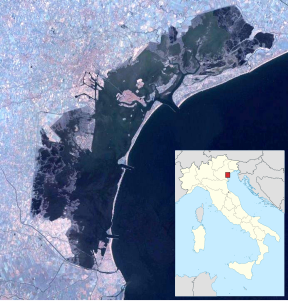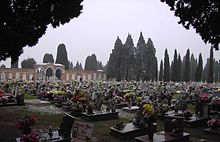San Michele (island)
| San Michele | ||
|---|---|---|
| View of San Michele from the southeast | ||
| Waters | Venice lagoon | |
| Geographical location | 45 ° 26 '48 " N , 12 ° 20' 49" E | |
|
|
||
| length | 460 m | |
| width | 390 m | |
| surface | 17.6 ha | |
| Highest elevation | 1 m | |
| Residents | 11 monks in the monastery (2001) 63 inhabitants / km² |
|
| main place | San Michele | |
| Map of the old town of Venice: San Michele is the rectangular island in the north of the old town (grid square G1) | ||
San Michele is an island in the Venice lagoon between Venice and Murano , on which the Venice cemetery of the same name is located. The island has an approximately rectangular floor plan, with a length of 460 meters, a width of 390 meters and an area of 17.6 hectares . The 2001 census shows 11 permanent residents on the island, all male. The island is struggling with a lack of space, which is why the dead are first buried in normal graves, but after a few years they are exhumed again and stacked in high blocks. San Michele is part of the parish of San Canciano in the sestiere (city sixth ) Cannaregio , although it belongs to the sestiere Castello .
history
Since the 13th century, in San Michele , a monastery of the Camaldoli from which even the cloister , of from 1,469 to Mauro Codussi built Renaissance church of San Michele in Isola and around 1530 by Guglielmo Bergamasco built hexagonal Cappella Emiliani have survived. It was in this monastery that the monk Fra Mauro drew his circular map of the world between 1457 and 1459 .
The island of San Cristoforo della Pace, which was connected to San Michele when it was converted to a cemetery, belonged to the monastery of the same name. In 1719 the monastery leased part of the island to the Evangelical Church of Augsburg Confession in Venice. The responsible health authority Magistrato della Sanità decreed that the leased property was to be surrounded by a wall so that it could not be seen from the outside. Access was only allowed from the waterfront, which the authorities justified with the necessary consideration for the Catholic cult. In 1810 the French government dissolved the San Cristoforo Monastery.
graveyard
After the secularization of the monastery and Napoleon's edict of June 11, 1804, which was also binding for Venice and with which the burial of the dead in the immediate vicinity of churches was prohibited, the monastery district on the island of San Cristoforo initially became the most important cemetery of the City redesigned, next to the Lutheran one that already existed there.
In order to gain more space for burials, part of the neighboring lagoon was filled in in 1837. “In the course of the earthworks to connect the two islands of S. Cristoforo and S. Michele to the new cemetery of the city, the burial place of the community [Augsburg Confession] was literally devastated and desecrated. At the protest of the community she was allowed to at least pick up the tombstones. As if that weren't enough, the community then received a horrific bill for the official closure of their cemetery, which they successfully fought against. "
The enlarged island of San Michele, surrounded by a wall, became the central cemetery, which replaced the previous cemeteries in the parish churches of Venice. From 1858 the cemetery was expanded under the direction of the Treviso architect Annibale Forcellini. Forcellini had the area filled up to make it flood-proof, straightened the area and surrounded it with a high brick wall along the straightened banks. The cemetery itself is laid out like a Greek cross , cypresses line the two main axes; the grave fields are separated by walls that contain the columbaria . The ossuaries are lined up on the north side .
Since the cemetery proved to be insufficient despite the expansion, the city began in 1998 with the project of an expansion of 60,000 m² with a planned 15,000 grave sites. The architect of this facility is David Chipperfield . The complex includes a chapel, a crematorium , columbaria, lawns and fountains. The new part of the cemetery, of which the first section has already been completed, is called Corte dei Quattro Evangelisti (Courtyard of the Four Evangelists ). In the meantime, a second extension courtyard has also been completed by Chipperfield, which differs from the first one, which was gray, by its white color. Currently (03-2017), a third extension in a yellow-reddish brick tone is about to be completed. A plaza was created between it and the previous expansion steps.
Buried here are u. a. the composers Ermanno Wolf-Ferrari , Luigi Nono and Igor Stravinsky , the poet Ezra Pound , the writer Joseph Brodsky and the ballet impresario Sergei Diaghilew , but also the Argentine football coach Helenio Herrera . There is a memorial plaque for the physicist Christian Doppler , but his burial place in Venice has not yet been found.
The older part of the cemetery is divided according to denomination, so numerous ambassadors from Nordic countries are buried in the Protestant part.
The island Sant'Ariano to the northeast behind Torcello served as ossuary "open air" for the cemeteries around. Behind an impenetrable wall of brambles, the bones are piled several meters high.
See also
Individual evidence
- ↑ [1]
- ↑ Actually, German merchants who were admitted to the Fondaco dei Tedeschi had an agreement with the Church of San Bartolomeo to bury their dead in its churchyard. After German Lutherans were repeatedly denied burial as heretics, the Evangelical Congregation looked for alternatives, whereby the unpaved Cimitero Acattolico on the Lido appeared unworthy.
- ↑ a b Stefan Oswald, The Inquisition, the Living and the Dead. Venice's German Protestants , Sigmaringen: Thorbecke, 1989, (= series of publications by the German Study Center in Venice / Centro Tedesco di Studi Veneziani; vol. 6), p. 67f. ISBN 3799527060 .
- ^ Stefan Oswald, The German Protestant Congregation in the Republic of Venice , Venice: Typescript, n.d., p. 13.
- ↑ Adam, Hubertus: The island of the dead . In: NZZ No. 54, March 6, 2009. p. 25.
Web links
- San Michele Island , venediginformationen.eu
- David Chipperfield Architects: San Michele Cemetery , divisare.com (English)








